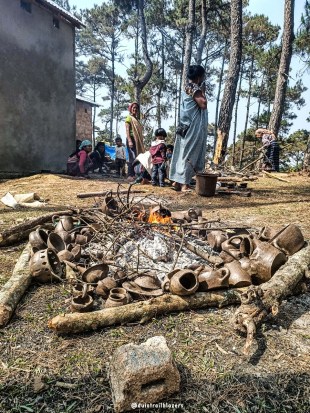In the quiet hills of West Jaintia, where clouds drift low over betel nut groves and the air carries the scent of damp earth, the small village of Larnai continues to shape one of Meghalaya’s oldest crafts — Khiew-Ranei, or black pottery. It is a practice that endures against odds, known for its distinct aesthetic, its strength, and its deep cultural resonance. The people who make it say little, but their hands tell stories — of patience, of inherited knowledge, of a bond between land and labour that has survived for generations.
Khiew-Ranei pottery is unlike any other. Its secret lies in the material — a blend of fine black clay and serpentine stone — and in the painstaking techniques that have been preserved and passed down through time. The process begins in winter, when the black clay is dug from the local soil of the Sung Valley region. The serpentine stones, found nearby, are collected separately, crushed by hand, and mixed with the clay to give the pottery its characteristic density and durability. The mixture is then pounded into pliant form and shaped entirely by hand — there are no wheels here, only the rhythm of wooden beaters and palm pressure shaping bowls, jars, and cooking vessels on low platforms in shaded courtyards.

The pots are left to dry in the open sun, sometimes for several days, depending on the weather. Once hardened, they are refined by beating to achieve symmetry and smoothness, a skill that takes years to perfect. Firing is done the traditional way — in an open-air pit, known locally as an open-kin. This stage alone can take up to three or four days, the flames and smoke gradually transforming the dull grey clay into a deep, lustrous black. While still hot, the pots are treated with a natural dye made from the bark of the u dieng sohliya tree, giving them their final burnished finish — a sheen that glows like obsidian when caught in the light.
The result is pottery that is both beautiful and functional. For centuries, the people of Larnai and neighbouring villages have used these vessels for cooking, storing water, steaming rice cakes like pu tharo, and in ceremonial contexts. Their porous structure keeps water cool, and their resilience makes them long-lasting even in everyday use. But beyond function, Khiew-Ranei represents something deeper — a connection to place, to tradition, and to a way of life that balances craft and ecology. Every element, from the raw clay to the firewood, is drawn from nature and returned to it. Yet, this tradition also bears the marks of struggle. Only a handful of families — mostly women — now continue the practice in Larnai.

Larnai lies about 58 kilometres from Shillong, a road journey that takes roughly two to two and a half hours. The nearest urban hub is Jowai, just 20 kilometres away, while the small town of Ummulong — about 4 kilometres from Larnai — serves as the nearest connection point, with shared sumos and taxis available from its taxi stand. From Shillong Airport, the distance is around 52 kilometres; from Guwahati Airport, about 166. The ideal season to visit is between October and March, when the weather is dry and the roads are easier to travel. Visitors are best advised to come during daylight hours, between 10 a.m. and 4 p.m., and, if possible, to travel with a guide or local companion familiar with the area and the language.
A visit here is not simply about observing a craft — it is about witnessing the living continuity of Meghalaya’s heritage. Travellers can participate in hands-on black pottery experiences, learn about the history and culture of Larnai, and savour Jaintia cuisine prepared in traditional earthenware. Each encounter deepens the understanding that Khiew-Ranei is not just a product, but a living art form shaped by patience, community, and resilience.
As dusk falls and smoke curls through the pine-lined slopes, the black pots gleam softly against the fading light — silent witnesses to generations of artisans who have moulded this clay, tended these fires, and kept alive a tradition that is as enduring as the hills themselves.


